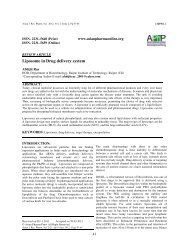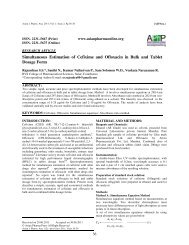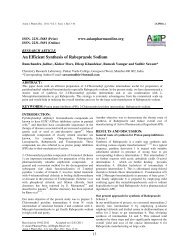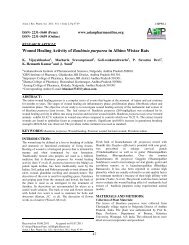Praecitrullus fistulosus: A Miraculous Plant - asian pharma press
Praecitrullus fistulosus: A Miraculous Plant - asian pharma press
Praecitrullus fistulosus: A Miraculous Plant - asian pharma press
You also want an ePaper? Increase the reach of your titles
YUMPU automatically turns print PDFs into web optimized ePapers that Google loves.
Asian J. Pharm. Tech. 2011; Vol. 1: Issue 1, Pg 9-12<br />
[AJPTech.]<br />
ISSN- 2231–5705 (Print)<br />
www.<strong>asian</strong><strong>pharma</strong>online.org<br />
ISSN- 2231–5713 (Online) 0974-3618<br />
REVIEW ARTICLE<br />
<strong>Praecitrullus</strong> <strong>fistulosus</strong>: A <strong>Miraculous</strong> <strong>Plant</strong><br />
Shweta Gautam 1 , Priya Singh 2 and Yogesh Shivhare 1 *<br />
1 Department of Pharmacognosy, RKDF College of Pharmacy, Bhopal (M.P.), India<br />
2 Department of Pharmacognosy, Lakshminarain College of Pharmacy, Bhopal (M.P.), India<br />
*Corresponding Author E-mail: yogesh_aot@rediffmail.com<br />
ABSTRACT:<br />
Many herbal remedies have been employed in various medical systems for the treatment and management of different<br />
diseases. During past several years, there has been growing interest among the usage of various medicinal plants from<br />
traditional system of medicine for the treatment of different ailments. Traditional system of medicinal consists of large<br />
number of plants with various medicinal and <strong>pharma</strong>cological importances and hence represents a priceless tank of<br />
new bioactive molecules. Genus <strong>Praecitrullus</strong> <strong>fistulosus</strong> is very similar to Citrullus in its morphological characters, but<br />
differs in the stratification of pollen grains, haploid chromosome number and to some extent in leaf morphology. This<br />
review attempts to encompass the available literature on <strong>Praecitrullus</strong> <strong>fistulosus</strong> with respect to its <strong>pharma</strong>cognostic<br />
characters, chemical constituents, summary of its various <strong>pharma</strong>cological activities and traditional uses.<br />
KEYWORDS: <strong>Praecitrullus</strong> <strong>fistulosus</strong>, Citrullus, Ecology<br />
INTRODUCTION:<br />
<strong>Plant</strong>s have played a significant role in maintaining human<br />
health and improving the quality of human life for<br />
thousands of years and have served humans as well as<br />
valuable components of medicines, seasonings, beverages,<br />
cosmetics and dyes. Herbal medicine is based on the<br />
premise that plants contain natural substances that can<br />
promote health and alleviate illness. 1 Herbal plants produce<br />
a variety of chemical compounds that act upon the body and<br />
are used to prevent or treat disease or promote health and<br />
well-being. Herbal drugs have increasingly been used<br />
worldwide during the last few decades as evidenced by<br />
rapidly growing global and national markets of herbal<br />
drugs. 2 Herbal medicines are in great demand in the<br />
developed as well as developing countries for primary<br />
healthcare because of their wide biological and medicinal<br />
activities, higher safety margins and lesser costs. 3 Herbal<br />
medicines may be associated with a broad variety of<br />
microbial loading and exert an important impact on the<br />
overall quality of herbal products and preparations.<br />
Generally, herbs are valued for their distinctive aroma,<br />
colour and flavor. Analysis of most frequently used plantbased<br />
therapies in the ayurvedic system revealed that 43%<br />
of them have been tested on humans, while 62% have been<br />
the subject of one or more animal studies. 4<br />
Received on 13.03.2011 Accepted on 22.04.2011<br />
© Asian Pharma Press All Right Reserved<br />
Asian J. Pharm. Tech. 1(1): Jan.-Mar. 2011; Page 9-12<br />
9<br />
This review attempts to include the existing literature on<br />
<strong>Praecitrullus</strong> <strong>fistulosus</strong> with respect to its <strong>pharma</strong>cognostic<br />
characters, chemical constituents, synopsis of its various<br />
<strong>pharma</strong>cological activities and traditional uses.<br />
<strong>Praecitrullus</strong> <strong>fistulosus</strong>:<br />
The Cucurbitaceous are mostly prostrate or climbing<br />
herbaceous annuals comprising about 90 genera and 700<br />
species that are further characterized by commonly having<br />
5-angled stems and coiled tendrils.<br />
Origin and geographical distribution:<br />
<strong>Praecitrullus</strong> <strong>fistulosus</strong> is cultivated as a vegetable in India,<br />
Pakistan and Afghanistan. The origin is probably northwestern<br />
India, where wild types may still be found in the<br />
wild. In Punjab, Uttar Pradesh, Mumbai and Rajasthan it is<br />
quite important as a cultivated market vegetable. The Hindi<br />
name ‘tinda’ is commonly used in other parts of the world.<br />
In Africa it is cultivated locally, mainly in East Africa, as a<br />
vegetable for the Asian population. In Ghana and Kenya it<br />
is grown as an export commodity for the United Kingdom<br />
market. It is also grown on a small scale in the United<br />
States. 5<br />
Synonyms:<br />
Citrullus <strong>fistulosus</strong> (Stocks), <strong>Praecitrullus</strong> <strong>fistulosus</strong><br />
(Stocks), Citrullus lanatus, Citrullus vulgaris var <strong>fistulosus</strong><br />
(Stocks), Colocynthis citrullus var. <strong>fistulosus</strong> (Stocks). 6
Asian J. Pharm. Tech. 2011; Vol. 1: Issue 1, Pg 9-12<br />
[AJPTech.]<br />
Ecology:<br />
Tinda is mainly cultivated in the lowlands from sea-level up<br />
to approximately 1000 m altitude. It likes warm, sunny<br />
conditions of 25–30°C at daytime and 18°C or more during<br />
the night and performs less well in cooler and humid areas.<br />
In India it is either grown in the dry season (February to end<br />
of April) or in the rainy season (mid-June to end of July).<br />
Tinda prefers light or sandy soils where its roots can<br />
penetrate easily. Moderately fertile to fertile soil is required<br />
for early closure of the vegetative cover.<br />
Diseases and Pests:<br />
The most serious fungal diseases are downy mildew<br />
(Pseudoperonospora cubensis) and to a lesser extent<br />
powdery mildew (Erysiphe cichoracearum and<br />
Sphaerotheca fuliginea), which can be controlled by<br />
spraying a carbamate fungicide. Choanephora<br />
cucurbitarum causes wet rot of the fruit and another major<br />
disease of the fruit is anthracnose caused by Colletotrichum<br />
gloeosporioides. There are also several virus diseases that<br />
can cause severe fruit abortion, defoliation and fruit<br />
distortion. These viruses are usually transmitted by aphids,<br />
thrips and white flies (Bemisia tabaci). Virus infections can<br />
be reduced by spraying appropriate insecticides and by<br />
early planting before the heavy rains. The most serious<br />
pests are melon fruit fly (Dacus spp.) and leaf beetles<br />
(Epilachna chrysomelina), which can be controlled with<br />
insecticides. 7<br />
Morphological characteristics: 8<br />
Leaves:<br />
Leaves are alternate and usually palmately 5-lobed or<br />
divided, stipules are absent. Leaves sparingly pinnatifid,<br />
lamina sparsely hispid all over, densely hispid on veins and<br />
veinlets of under surface, margin minutely denticulate,<br />
apparently entire, young leaves villous to densely hispid.<br />
Probract spathulate 0.8 cm long.<br />
Levels of seed proteins in Citrullus and <strong>Praecitrullus</strong><br />
accessions:<br />
Variation among 17 accessions of Citrullus lanatus from<br />
different geographic regions and interspecific relationships<br />
of six taxa of Citrullus and <strong>Praecitrullus</strong> were studied using<br />
electrophoretic patterns of their seed storage proteins.<br />
Globulins, the salt soluble proteins, represented the major<br />
fraction with their proportion varying between 56.6% and<br />
67.0%. These were followed by albumins (16.6-20.8%) and<br />
glutelins (13.5-18.5%) with prolamins as the lowest (2.2-<br />
4.1%) of the four fractions. Two-dimensional gel<br />
electrophoresis under non reducing conditions in the first<br />
dimension and reducing conditions in the second revealed<br />
disulphide-bonded subunit pairs of molecular weight 53, 52,<br />
50 and 41 kDa, unlike the single subunit pair generally<br />
reported in different cucurbits, each consisting of a large<br />
and a small subunit. In the UPGMA dendrogram based on<br />
polypeptide patterns, the occurrence of C. lanatus var.<br />
lanatus, C. lanatus var. citroides and C. lanatus accession<br />
PI 482318 in one sub cluster suggested that<br />
phylogenetically C. lanatus var. citroides and C. lanatus<br />
var. lanatus are closely related. The recently described<br />
annual wild species, Citrullus rehmii, occurred<br />
independently nearest to the subcluster of these cultivated<br />
and wild taxa. Citrullus colocynthis, the perennial wild<br />
species occurred farther from this cluster showing relatively<br />
more genetic distance from the watermelons. <strong>Praecitrullus</strong><br />
<strong>fistulosus</strong> was out clustered and appeared genetically distant<br />
from all the Citrullus taxa; this supported its placement in a<br />
separate genus unlike its nomenclature as a botanical<br />
variety of watermelon or as a separate species of Citrullus<br />
proposed in certain earlier studies. 9<br />
Flowers:<br />
Flowers are actinomorphic and nearly always unisexual.<br />
The perianth has a short to prolonged epigynous zone that<br />
bears a calyx of 3-6 lobes and 3-6 petals or more frequently<br />
a 3-6 lobed sympetalous corollas. The androecium is highly<br />
variable, consisting of basically 5 distinct to completely<br />
connate stamens that frequently are twisted, folded or<br />
reduced in number. The gynoecium consists of a single<br />
compound pistil of 2-5 carpels, generally with one style and<br />
as many style branches or major stigma lobes as carpels,<br />
and an inferior ovary with one locule and usually numerous<br />
ovules on 2-5 parietal placentae or 3 locules with numerous<br />
ovules on axile placentae.<br />
Fruits<br />
The fruit is a type of berry called a pepo by Gerald Carr.<br />
The fruit is approximately spherical, and 5–8 cm in<br />
diameter. Fruit about the size of a small turnip, de<strong>press</strong>ed at<br />
each end, hispid when young afterwards glabrous.<br />
10<br />
Thiamin<br />
Carotene<br />
Ascorbic acid, Riboflavin, Niacin<br />
Traditional uses<br />
10, 11<br />
<strong>Praecitrullus</strong> <strong>fistulosus</strong> may be a useful source of resistance<br />
to whiteflies for the improvement of watermelons. Tinda is<br />
an immature fruits are used in rayata or vegetable curries.<br />
The seeds of tinda are roasted and consumed in the same<br />
way as watermelon or egusi seeds. In India tinda is used as<br />
fodder and in medicine. The entire immature fruit is used as
Asian J. Pharm. Tech. 2011; Vol. 1: Issue 1, Pg 9-12<br />
a cooked vegetable. In India the fruits are also pickled and<br />
candied.<br />
[AJPTech.]<br />
Table 1 Vernacular names of <strong>Praecitrullus</strong> <strong>fistulosus</strong> 12<br />
Languages Vernacular names<br />
English Indian round melon, Indian round gourd, Round<br />
gourd, Round melon. Indian Round Gourd, Indian<br />
Round Melon, Round Gourd, Round Melon, Round-<br />
Melon, Squash-Melon, Tinda.<br />
Marathi Dhemase<br />
Punjab Tandus,Tendu,Tinda<br />
Nepalese Matyangre pharsi, Tinda pharsii (Tinda pharsi).<br />
Rajasthan Tindsi<br />
Sind Dilpasand<br />
Telugu Tinda kaaya<br />
Tamil Kovaikkaai<br />
13, 14<br />
Table 2 Chemical constituents<br />
Chemical constituents Quantity (per100g edible portion)<br />
Water 93.5g<br />
Protein 1.4g<br />
Fat 0.2g<br />
Carbohydrate 3.6g<br />
Fibre 1.6g<br />
Calcium<br />
25mg<br />
Iron<br />
0.9mg<br />
Potassium<br />
24mg<br />
Carotene<br />
13g<br />
Thiamin<br />
0.04mg<br />
Riboflavin<br />
0.08mg<br />
Niacin<br />
0.3mg<br />
Ascorbic acid<br />
18mg<br />
Copper<br />
11ppm<br />
Nikel<br />
Asian J. Pharm. Tech. 2011; Vol. 1: Issue 1, Pg 9-12<br />
REFERENCES:<br />
1. Moon Komal, Khadabadi SS, Deokate UA and Deore SL.<br />
Caesalpinia bonducella F – An Overview. Report and Opinion.<br />
2 (3); 2010: 83-90.<br />
2. Bhowmik Debjit, Kumar KP Sampath, Tripathi Pankaj and<br />
Chiranjib B. Traditional Herbal Medicines: An Overview.<br />
Archives of Applied Science Research.1 (2); 2009: 165-177.<br />
3. Chaudhary Gagandeep, Goyal Sandeep and Priyanka Poonia.<br />
Lawsonia inermis Linnaeus: A Phyto<strong>pharma</strong>cological Review.<br />
International Journal of Pharmaceutical Sciences and Drug<br />
Research. 2 (2); 2010: 91-98.<br />
4. Aneesh TP, Hisham Mohame, M Sonal Sekhar, Madhu<br />
Manjusree and Deepa TV. International market scenario of<br />
traditional Indian herbal drugs – India declining. International<br />
Journal of Green Pharmacy. 3 (3); 2009: 184-190.<br />
5. Schippers RR. <strong>Praecitrullus</strong> <strong>fistulosus</strong> (Stocks) Pangalo In:<br />
Grubben, GJH & Denton, O.A. (Editors), PROTA 2:<br />
Vegetables/Légumes [CD-Rom]. PROTA, Wageningen,<br />
Netherlands, 1994.<br />
6. http/www.efloras.org.<br />
7. http/www.database prota.org<br />
8. http/www.wikipedia.org.<br />
9. http/www.springerlink.com.<br />
10. Levi Amnon, Thomas E Claude, Simmons M Alvin and Thies A<br />
Judy. Analysis based on RAPD and ISSR markers reveals closer<br />
similarities among Citrullus and Cucumis species than with<br />
<strong>Praecitrullus</strong> <strong>fistulosus</strong> (Stocks) Pangalo. Genetic Resources<br />
and Crop Evolution. 52; 2005: 465–472.<br />
11. Central Instiute of arid horticulture, Bikaner. Annual report.<br />
2003- 2004: 1- 121.<br />
12. Kirtikar KR and Basu BD. A text book of Indian medicinal plant.<br />
Second Edition. Allahabad: Lalit Mohan Basu, M B 49; Leader<br />
Road 1998:1151.<br />
13. Holland B, Unwin ID & Buss DH. Vegetables, herbs and spices.<br />
The fifth supplement to McCance & Widdowson’s. The<br />
Composition of Foods. 4th Edition. Royal Society of Chemistry,<br />
Cambridge, United Kingdom. 1991: 163.<br />
14. Hussain Javid, Rehmaan Nazeeb Ur, Khan Abdul latif, Hamayun<br />
Muhammahad, Hussain S Murtaza and Shinwari Zabta khan.<br />
Proximate and essential nutrients evaluation of selected vegetable<br />
spieces from kohat region, Pakistan. Pakistan journal of botany.<br />
42 (4); 2010: 2847-2855.<br />
[AJPTech.]<br />
12

















